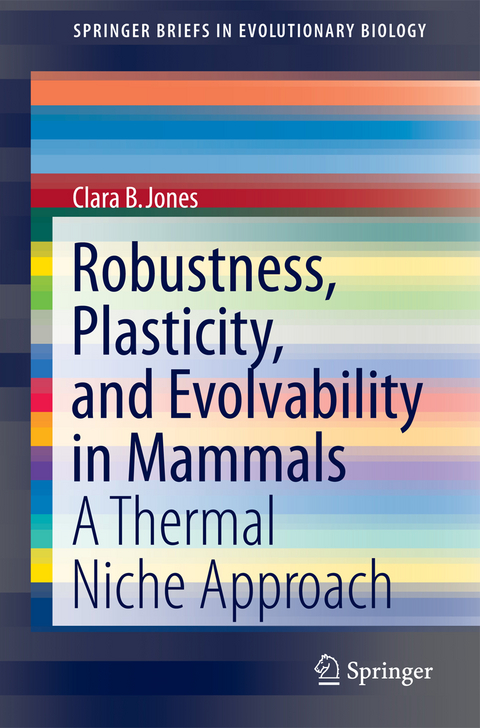
Robustness, Plasticity, and Evolvability in Mammals
A Thermal Niche Approach
Seiten
2012
|
2012 ed.
Springer-Verlag New York Inc.
978-1-4614-3884-7 (ISBN)
Springer-Verlag New York Inc.
978-1-4614-3884-7 (ISBN)
This book offers new views on robustness and weak robustness, plasticity and evolvability, emphasizing the adaptive complex in relation to endogenous and exogenous organismal features which can induce or constrain variability and novelty of form and function.
Among the unresolved topics in evolutionary biology and behavioral ecology are the origins, mechanisms, evolution, and consequences of developmental and phenotypic diversity. In an attempt to address these challenges, plasticity has been investigated empirically and theoretically at all levels of biological organization—from biochemical to whole organism and beyond to the population, community, and ecosystem levels. Less commonly explored are constraints (e.g., ecological), costs (e.g., increased response error), perturbations (e.g., alterations in selection intensity), and stressors (e.g., resource limitation) influencing not only selective values of heritable phenotypic components but, also, decisions and choices (not necessarily conscious ones) available to individuals in populations. Treating extant mammals, the primary purpose of the proposed work is to provide new perspectives on common themes in the literature on robustness (“functional diversity”; differential resistance to “deconstraint” of conserved elements) and weak robustness (the potential to restrict plasticity and evolvability), plasticity (variation expressed throughout the lifetimes of individuals in a population setting “evolvability potential”), and evolvability (non-lethal phenotypic novelties induced by endogenous and/or exogenous stimuli). The proposed project will place particular emphasis upon the adaptive complex in relation to endogenous (e.g., genomes, neurophysiology) and exogenous (abiotic and biotic, including social environments) organismal features discussed as regulatory and environmental perturbations with the potential to induce, and, often, constrain variability and novelty of form and function
Among the unresolved topics in evolutionary biology and behavioral ecology are the origins, mechanisms, evolution, and consequences of developmental and phenotypic diversity. In an attempt to address these challenges, plasticity has been investigated empirically and theoretically at all levels of biological organization—from biochemical to whole organism and beyond to the population, community, and ecosystem levels. Less commonly explored are constraints (e.g., ecological), costs (e.g., increased response error), perturbations (e.g., alterations in selection intensity), and stressors (e.g., resource limitation) influencing not only selective values of heritable phenotypic components but, also, decisions and choices (not necessarily conscious ones) available to individuals in populations. Treating extant mammals, the primary purpose of the proposed work is to provide new perspectives on common themes in the literature on robustness (“functional diversity”; differential resistance to “deconstraint” of conserved elements) and weak robustness (the potential to restrict plasticity and evolvability), plasticity (variation expressed throughout the lifetimes of individuals in a population setting “evolvability potential”), and evolvability (non-lethal phenotypic novelties induced by endogenous and/or exogenous stimuli). The proposed project will place particular emphasis upon the adaptive complex in relation to endogenous (e.g., genomes, neurophysiology) and exogenous (abiotic and biotic, including social environments) organismal features discussed as regulatory and environmental perturbations with the potential to induce, and, often, constrain variability and novelty of form and function
1. Introduction: What paths to mean reproductive success of individuals and shifting mean fitness of mammalian populations?.- 2. Mammals: From humble vertebrate beginnings to global terrestrial dominance.- 3. Variability of mammalian thermal niches: Differential effects of local and global environmental heterogeneity.- 4. Robustness and polyphenisms in mammals: ?Core processes?, repatterning, ?constrained variation?, and ?regulatory logic?.- 5. Learning may generate phenotypic variability in heterogeneous regimes.- 6. Discussion: Stimulus ? Response ? Stimulus.- 7. Synopsis.- References.
| Reihe/Serie | SpringerBriefs in Evolutionary Biology |
|---|---|
| Zusatzinfo | 5 Illustrations, color; 9 Illustrations, black and white; XIII, 108 p. 14 illus., 5 illus. in color. |
| Verlagsort | New York, NY |
| Sprache | englisch |
| Maße | 155 x 235 mm |
| Themenwelt | Naturwissenschaften ► Biologie ► Evolution |
| Naturwissenschaften ► Biologie ► Genetik / Molekularbiologie | |
| Naturwissenschaften ► Biologie ► Ökologie / Naturschutz | |
| Naturwissenschaften ► Biologie ► Zoologie | |
| ISBN-10 | 1-4614-3884-5 / 1461438845 |
| ISBN-13 | 978-1-4614-3884-7 / 9781461438847 |
| Zustand | Neuware |
| Haben Sie eine Frage zum Produkt? |
Mehr entdecken
aus dem Bereich
aus dem Bereich
Wie die Vernichtung der Arten unser Überleben bedroht - Der …
Buch | Softcover (2023)
Penguin (Verlag)
15,00 €


